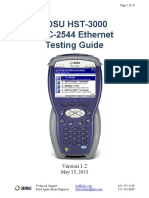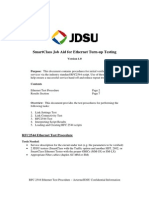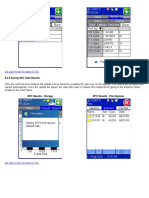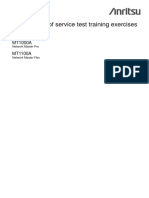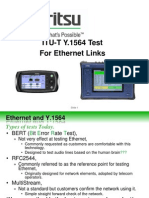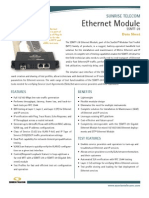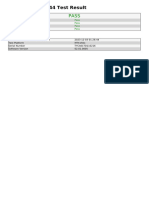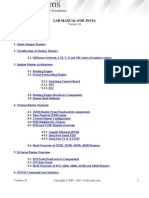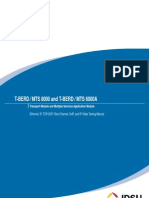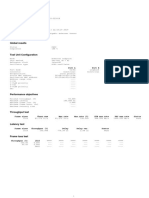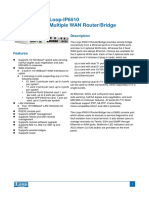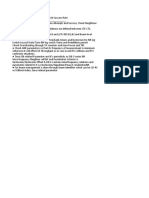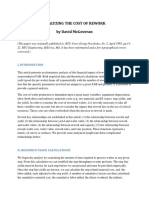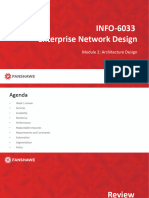MTS/T-BERD - 5800
Hardware Description
2
�User Interface
3
�RFC 2544
�RFC 2544 Test Procedure
Select Test In the Select Test menu, ,at the top left corner of the screen,
choose one of the following:
• For 10BASE-T, 100BASE-T, or 1000BASE-T Electrical Ethernet testing:
Ethernet►10/100/1000► RFC 2544 ►L2 Traffic►P1 Terminate.
• For 100BASE-FX Optical Fast Ethernet testing:
Ethernet►100M Optical► RFC 2544 ►L2 Traffic►P1 Terminate.
• For 1000BASE-SR, 1000BASE-LR, or other GigE Optical Testing:
Ethernet►1GigE Optical►RFC 2544 ►L2 Traffic►P1 Terminate.
• For 10GBASE-SR, 10GBASE-LR, other 10GigE Optical Testing:
Ethernet►10GigE LAN► RFC 2544 ►L2 Traffic►P1 Terminate.
5
�RFC 2544 Test Procedure - Configure
If this is the first time using the RFC2544 test and your unit does not have pre-
loaded configuration files, tap the button next to “Start a New Configuration (reset
to defaults)” and proceed to step 2.
Otherwise, tap the button next to “Load Configuration from a Profile”
Select the desired configuration, and tap . Tap to acknowledge
successful load, tap the button, and tap the button next to Edit
Configuration.
6
�RFC 2544 Test Procedure - Symmetry
In the Symmetry configuration screen, verify that Throughput = Symmetric and
Measurements = Loopback, then tap the button.
7
�RFC 2544 Test Procedure – L2 Settings
Option Value(s) Comment
Frame Type DIX
Encapsulation None or VLAN See Work Order
Select “LBM Traffic” if the
Traffic or LBM loopback device is an ALU
Test Mode
Traffic 7705. Select “Traffic” for all
other loopback devices.
VLAN ID See Work Order Option only displayed if
User Priority 0 (lowest) Encapsulation = VLAN
Source Type Factory Default Tap the Set Loop Type and MAC
Enter MAC address Addresses or Set MAC Addresses
Destination MAC of the loopback and LBM links to configure
device these settings. (See below)
Loop Type Unicast
EtherType 0800 Options only displayed if Test
Auto-increment Mode = Traffic
No
SA MAC
See work order. Set
Maint. Domain
to same value as
Level Options only displayed if Test
ALU 7705
Mode = LBM Traffic
Enable Sender
No (unchecked)
TLV
8
�RFC 2544 Test Procedure – Other Settings
Use the or button at the bottom of the screen to advance through the
wizard and configure the remaining settings as follows:
Screen Option Value(s) Comment
RFC 2544 Tests: Do you want to use
Configuration a configuration No
Templates template?
Throughput,
RCF 2544 Tests Latency,
RFC 2544 Tests:
Frame Loss
Select Tests
Additional Tests Packet Jitter
9
�RFC 2544 Test Procedure – Other Settings
Bandwidth Unit L1 Mbps
Enter Committed Information
Maximum Bandwidth See Work Order
Rate (CIR)
Select 1st, 4th, and 8th
RFC 2544 Tests: Frame Lengths.
Utilization
If the MTU is greater than
1518 (1522 with VLAN),
Frame Lengths also enter and select the
frame length
of the MTU.
Deselect (uncheck) all
other frame sizes.
Zero-in Process JDSU Enhanced
RFC 2544 Tests:
Throughput Measurement Accuracy To within 1 Mbps
10
�RFC 2544 Test Procedure – Other Settings
Test Procedure RFC 2544 Standard
Enter minimum value:
RFC 2544 Tests: 1 for 100Mbps
Frame Loss Test Bandwidth Granularity Ethernet
(L1Mbps) 10 for Gigabit
Ethernet
100 for 10GigE
Configure test durations
No
separately?
Test Ctls:
Duration 120 seconds
Test Durations This will result in
approximately 6 minutes of
Number of Trials 1 test time per frame length.
Show Pass/Fail Select all ()
Throughput Threshold See Work Order Enter CIR
Throughput Frame Loss
See Work Order Enter 0.000 if not specified
Tolerance (%)
Latency RTD (µs) See Work Order
Test Ctls:
Test Thresholds Enter threshold in µsecs
(1 msec = 1000 µsec).
Uncheck the
Packet Jitter (µs) See Work Order Show Pass/Fail box if a
threshold is not specified.
Acterna Payload Version Version 2
11
�RFC 2544 Test Procedure – Save Profile
In the Save Profiles screen, enter a Filename, and tap . Tap ,
tap , and tap twice.
12
�RFC 2544 Test Procedure – Running the Test
Ensure that the loopback device has been setup, and tap to run
J- QuickCheck to verify local connectivity, loop up the remote loopback device,
and check available bandwidth.
13
�RFC 2544 Test Procedure – Running the Test
Tap , and tap . The T-BERD will loop up the loopback device
and run all configured tests.
Detailed results for each test can be viewed by tapping .
14
�RFC 2544 Test Procedure – Create a Report
Tap twice and enter Customer name, Technician ID, Test Location, Work
Order Number and Comments/Notes.
Tap again and tap
View the Report and tap
15
�Y.1564
�Y.1564 Test Procedure
Select Test In the Select Test menu, ,at the top left corner of the screen,
choose one of the following:
• For 10BASE-T, 100BASE-T, or 1000BASE-T Electrical Ethernet testing:
Ethernet►10/100/1000► Y1564 SAMComplete ►L2 Traffic►P1 Terminate.
• For 100BASE-FX Optical Fast Ethernet testing:
Ethernet►100M Optical► Y1564 SAMComplete ►L2 Traffic►P1 Terminate.
• For 1000BASE-SR, 1000BASE-LR, or other GigE Optical Testing:
Ethernet►1GigE Optical► Y1564 SAMComplete ►L2 Traffic►P1 Terminate.
• For 10GBASE-SR, 10GBASE-LR, other 10GigE Optical Testing:
Ethernet►10GigE LAN► Y1564 SAMComplete ►L2 Traffic►P1 Terminate.
17
�Y.1564 Test Procedure - Configure
If this is the first time using the Y.1564 test and your unit does not have pre-loaded
configuration files, tap the button next to “Start a New Configuration (reset to
defaults)” and proceed to step 2.
Otherwise, tap the button next to “Load Configuration from a Profile”
Select the desired configuration, and tap . Tap to acknowledge
successful load, tap the button, and tap the button next to Edit
Configuration.
18
�Y.1564 Test Procedure - Setup
Use the and buttons at the bottom of the screen to advance through
the wizard and configure Layer 2 Network Setting as follows:
Screen Option Value(s) Comment
Throughput Symmetric
Connect: Symmetry
Measurements Loopback
Connect: Configuration Do you want to use a
No
Templates configuration template?
Connect: Local Settings Frame Type DIX
Number of Services See Work Order Enter 1 if not specified.
Select “LBM Traffic” if the
Network Services loopback device is an ALU 7705.
Test Mode Traffic or LBM Traffic
Select “Traffic” for all other
loopback devices.
19
�Y.1564 Test Procedure - Setup
Maint. Domain Level See Work Order
Network: Services, Tap the LBM settings link to configure
LBM Settings (Advanced) Enable Sender TLV No (unchecked) these settings.
See Work Order; Enter EMIX if not Tap the DA MAC and Frame Size
Network: Services, Network Frame Size
specified settings link to configure these
Settings (Advanced)
Dest. MAC Address See Work Order settings.
Do Services have different
See Work Order Select No if not specified
VLAN ID’s or User Priorities?
Network: Tagging None or VLAN.
Encapsulation See Work Order
Select None if not specified
VLAN ID See Work Order
User Priority See Work Order
Enable Aggregate Mode No (unchecked)
CIR See Work Order
SLA: EIR See Work Order Enter 0 if not specified
SLA Throughput
Select if
CIR < line rate.
Policing
Deselect if
CIR = line rate
20
�Y.1564 Test Procedure - Setup
Would you like to perform burst
See Work Order Select No if not specified
SLA: testing?
SLA Burst Burst Test Type Committed Burst Size
CBS See Work Order
Frame Loss Ratio See Work Order Enter 0.000000 if not specified.
If not specified:
50 for Circuit Emulation
Frame Delay (RTD, ms) See Work Order
20 for EPL/EVPL
10 for Mobile Backhaul
SLA:
SLA Performance If not specified:
20 for Circuit Emulation
Delay Variation (ms) See Work Order
20 for EPL/EVPL
2 for Mobile Backhaul
Select “Version 3” if loopback device
Acterna Payload Version is another T-BERD.
Otherwise, select “Version 2”
Number of Steps Below CIR 3
Test Controls
Step Duration (Sec) 15
Test Duration 5
21
�Y.1564 Test Procedure – Save Profile
In the Save Profiles screen, enter a Filename, and tap . Tap ,
tap , and tap twice.
22
�Y.1564 Test Procedure – Running the Test
In the Select Y.1564 Tests screen, select all Services, Service Configuration Test,
Service Performance Test, and Throughput (RFC-2544). Enter the total (Sum) CIR
for all combined services in the Max. (L1 Mbps) field, then press
23
�Y.1564 Test Procedure – Running the Test
Ensure that the loopback device has been setup, and tap to run
J-QuickCheck to verify local connectivity, loop up the remote loopback device, and
check available bandwidth.
24
�Y.1564 Test Procedure – Running the Test
Tap , and tap . The T-BERD will run all configured tests.
Detailed results for each test can be viewed by tapping .
25
�Y.1564 Test Procedure – Create a Report
Tap twice and enter Customer name, Technician ID, Test Location, Work
Order Number and Comments/Notes.
Tap again and tap
View the Report and tap
26
�Software Update
�Software update
Power On - Press and hold the
ON/OFF button to turn on the T-
BERD 5800v2.
AC Power - Connect the AC power
adapter to the power connector on
the side of the T-BERD 5800v2.
LAN Connection - Connect the
Ethernet Management Port on the
side of T-BERD 5800v2 to a
network connection with internet
access, using CAT 5E or better
cable.
28
�Software update – Network Upgrade
Press the System icon, , at the top of the start-up screen, to display the
System Menu.
29
�Software update – Network Upgrade
Press the Network icon, , to display LAN Settings. Set IP Mode to
“DHCP” for automatic IP address assignment or “Static” for manual input.
After configuring LAN settings, press the System icon, , to redisplay
the System Menu.
30
�Software update – Network Upgrade
Press the Upgrade icon, , to display upgrade methods.
31
�Software update – Network Upgrade
Press to display upgrade settings. Ensure
that Server Address = “5800v2.updatemyunit.net”
32
�Software update – Network Upgrade
Press to show the upgrade versions
available at upgrademyunit.net.
Press , and press to initiate the upgrade.
33
�Software update – USB Upgrade
Using an internet browser on your PC or laptop, go to http://updatemyunit.net/
34
�Software update – USB Upgrade
Click on to display the T-BERD 5800v2 upgrade portal.
Download the file by clicking one of the flags and save extract the files in a
USB
35
�Software update – USB Upgrade
Press the Upgrade icon, , to display upgrade methods.
36
�Software update – Network Upgrade
Press to show the upgrade versions available at
upgrademyunit.net.
Press , and press to initiate the upgrade.
37
